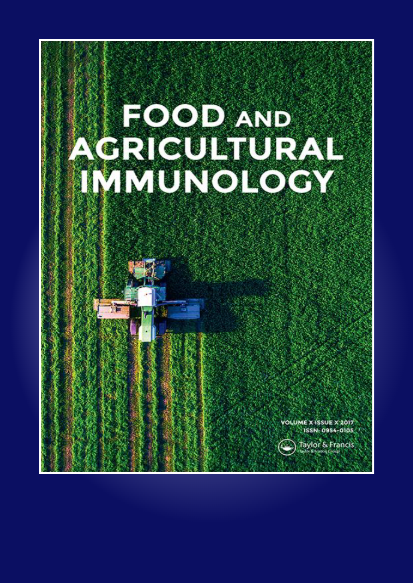Aflatoxin B1 variations in animal feeds along the supply chain in Tanzania and its possible reduction by heat treatment
IF 2.1
3区 农林科学
Q3 CHEMISTRY, APPLIED
引用次数: 3
Abstract
ABSTRACT This study evaluated the presence of aflatoxin B1 in five different animal feeds collected from manufacturers, suppliers and consumers and its possible reduction by heating at 100°C for 180 min. A total of 160 animal feed samples were collected and analyzed by using lateral flow immunoassay method. The results revealed that all animal feeds analyzed were positive for aflatoxin B1 with 91% samples containing high concentrations ranging from 24.00 to 76.23 ng/g above the international allowable standard for animal feeds (20 ng/g). Maize bran (76 ng/g) and sunflower cake (63 ng/g) had higher aflatoxin B1 concentrations, correlating with higher moisture content. Upon heating the feeds, aflatoxin B1 was reduced to a concentration ranging from 2.24 to 9.78 ng/g (<20 ng/g). Our study suggests high potential health problems to animals and humans from aflatoxins requiring proper heating and frequent monitoring of the animal feeds for aflatoxin B1.坦桑尼亚供应链动物饲料中黄曲霉毒素B1的变异及其通过热处理可能减少
摘要本研究评估了从制造商、供应商和消费者处收集的五种不同动物饲料中黄曲霉毒素B1的存在,以及在100°C下加热180 min共采集160份动物饲料样品,采用侧流免疫分析法进行分析。结果显示,所有分析的动物饲料都对黄曲霉毒素B1呈阳性,91%的样本含有24.00至76.23的高浓度黄曲霉毒素 ng/g高于动物饲料的国际允许标准(20 ng/g)。玉米糠(76 ng/g)和向日葵蛋糕(63 ng/g)具有较高的黄曲霉毒素B1浓度,与较高的水分含量相关。在加热饲料时,黄曲霉毒素B1的浓度降低到2.24至9.78 纳克/克(<20 ng/g)。我们的研究表明,黄曲霉毒素对动物和人类有很高的潜在健康问题,需要对动物饲料进行适当的加热和频繁的黄曲霉毒素B1监测。
本文章由计算机程序翻译,如有差异,请以英文原文为准。
求助全文
约1分钟内获得全文
求助全文
来源期刊

Food and Agricultural Immunology
农林科学-毒理学
CiteScore
5.30
自引率
6.70%
发文量
52
审稿时长
2 months
期刊介绍:
Food and Agricultural Immunology is an international open access journal publishing original immunological research with applications in food, agricultural, environmental and veterinary science. Submissions describing the use of immunological techniques and methods are particularly welcomed.
The journal aims to expand our understanding of the interactions at the interface of food and immune systems including studies on:
-Development of diagnostic systems – all types of ligand-based assays, e.g. antibody, aptamer
-Application of ligand-based assays for the detection or identification of molecules of interest in food science, agricultural research, veterinary investigations and clinical systems relating to food allergy or sensitivity to agricultural chemicals
-Effects of food on the immune system
-Studies on allergy and allergic reactions
-Investigations into food allergies
-Development of allergen-free food systems
-Development of novel assay formats
-Applications of assay systems to the monitoring of food items in relation to safety and labelling
-Food quality issues, e.g. speciation, adulteration and contamination
-Comparisons between different analytical techniques
The journal publishes research and review articles and is essential reading for food scientists, immunologists and all those concerned with the interaction between food and immune systems.
 求助内容:
求助内容: 应助结果提醒方式:
应助结果提醒方式:


